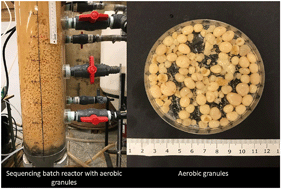当前位置:
X-MOL 学术
›
Environ. Sci.: Water Res. Technol.
›
论文详情
Our official English website, www.x-mol.net, welcomes your feedback! (Note: you will need to create a separate account there.)
Aerobic granulation for future wastewater treatment technology: challenges ahead
Environmental Science: Water Research & Technology ( IF 5 ) Pub Date : 2017-10-10 00:00:00 , DOI: 10.1039/c7ew00148g S. J. Sarma 1, 2, 3, 4, 5 , J. H. Tay 1, 2, 3, 4, 5
Environmental Science: Water Research & Technology ( IF 5 ) Pub Date : 2017-10-10 00:00:00 , DOI: 10.1039/c7ew00148g S. J. Sarma 1, 2, 3, 4, 5 , J. H. Tay 1, 2, 3, 4, 5
Affiliation

|
Aerobic granules were discovered around 20 years back. These are spherical aggregates of mixed microbial culture, typically around 0.5–3 mm in diameter. Aerobic granule-based wastewater treatment technology has been successfully used on a full-scale for real wastewater treatment. It is argued that the aerobic granule-based technology can potentially replace the traditional activated sludge process. The first of its advantages is that aerobic granule-based wastewater treatment plants can be built within around one quarter of the land occupied by conventional activated sludge-based plants. Additionally, this technology can reduce the operating cost by nearly 25%. Reduction in sludge production and reduction in energy consumption (around 30%) are other benefits of this technology. Granule formation is a relatively slow process. In fact, the time taken for granule formation is a challenge for a full-scale application of this technology. The mechanism behind aerobic granule formation is not fully understood. Thus, further investigation of the molecular mechanism of granule formation would be crucial for the successful commercialization of this technology.
中文翻译:

未来废水处理技术的好氧制粒:未来的挑战
大约20年前就发现了好氧颗粒。这些是混合微生物培养物的球形聚集体,通常直径约为0.5–3 mm。基于好氧颗粒的废水处理技术已成功地全面用于实际废水处理。有人认为,基于好氧颗粒的技术可以替代传统的活性污泥工艺。它的第一个优点是,可在基于传统活性污泥的工厂所占土地的约四分之一的土地上建造好氧颗粒废水处理厂。此外,该技术可以将运营成本降低近25%。减少污泥的产生和减少能源消耗(约30%)是该技术的其他好处。颗粒形成是一个相对缓慢的过程。实际上,颗粒形成所需的时间对于该技术的全面应用是一个挑战。有氧颗粒形成的机理尚不完全清楚。因此,进一步研究颗粒形成的分子机制对于该技术的成功商业化至关重要。
更新日期:2017-10-10
中文翻译:

未来废水处理技术的好氧制粒:未来的挑战
大约20年前就发现了好氧颗粒。这些是混合微生物培养物的球形聚集体,通常直径约为0.5–3 mm。基于好氧颗粒的废水处理技术已成功地全面用于实际废水处理。有人认为,基于好氧颗粒的技术可以替代传统的活性污泥工艺。它的第一个优点是,可在基于传统活性污泥的工厂所占土地的约四分之一的土地上建造好氧颗粒废水处理厂。此外,该技术可以将运营成本降低近25%。减少污泥的产生和减少能源消耗(约30%)是该技术的其他好处。颗粒形成是一个相对缓慢的过程。实际上,颗粒形成所需的时间对于该技术的全面应用是一个挑战。有氧颗粒形成的机理尚不完全清楚。因此,进一步研究颗粒形成的分子机制对于该技术的成功商业化至关重要。



























 京公网安备 11010802027423号
京公网安备 11010802027423号